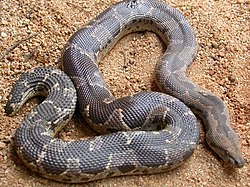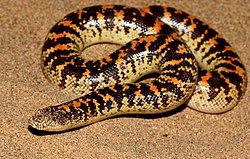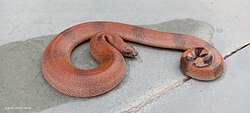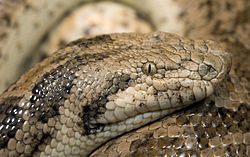ar
الأسماء في صفحات التنقل


Yatağ ilanlar, və ya Qum yatağan ilanları (lat. Eryx) – Yatağanlar fəsiləsinə aid ilan cinsi.
Bu cinsə daxil olan ilan növlərinin yalnız az qismi qumda yuxa qururlar. Digər qismi isə gilli, çınqıllı və daşlıqlı ərazilərdə yuxa qurur. Bədəni silindirik formaya malik olur və əzələ sistemi yaxşı inkişaf etmişdir. Quyruğu isə çox qısadır. Gözləri xırda olub yuxarı istiqamətlənmiş formadadır. Ön dişləri arxa dişlərinə nisbətən uzundur. Onlar əsasən öz ovunu əzələli bədəni ilə sıxaraq öldürürlər. Əsasən kərtənkələlərlə qodalanır. Dişilər 20 bala doğa bilir.
Yatağanlar Şimali və Cənubi Afrika, Mərkəzi və Cənubi Asiya, Qafqaz və Balkan yarımadası kimi ərazilərdə yayılmışdır.
Növ 9 növə bölünür:
Yatağ ilanlar, və ya Qum yatağan ilanları (lat. Eryx) – Yatağanlar fəsiləsinə aid ilan cinsi.
Die Sandboas (Eryx) sind eine Schlangengattung aus der Familie der Boas. Die Gattung umfasst zwölf Arten, die vor allem in Afrika, dem Nahen Osten und Asien bis Indien anzutreffen sind. Die Westliche Sandboa ist die einzige Riesenschlange, die auch in größeren Bereichen Europas zu finden ist, das Areal der Östlichen Sandboa berührt Europa nur am Nordrand des Kaspischen Meeres.
Der Gattungsname Eryx wurde nach der mythologischen Gestalt Eryx, Sohn der Aphrodite, gewählt. Eryx wurde von Herakles beim Ringkampf erwürgt.[1] Er war der eponyme Regent der Stadt Eryx auf dem gleichnamigen Berg auf Sizilien, heute italienisch Erice genannt.
Bei den Sandboas handelt es sich um kleine bis mittelgroße Schlangen, die Körperlängen von 40 cm bis etwa 100 cm erreichen. Die kleinste Art ist dabei die Afghanische Sandboa (Eryx elegans), die längste die Indische Sandboa (Eryx johnii). Der Habitus der Schlangen ist weitestgehend gedrungen mit kurzem Schwanz, der Kopf ist vom Körper nicht abgesetzt.
Kennzeichnend ist ein sehr großes Schnauzenschild, welches bis weit auf die Kopfoberseite reicht und sich aus dem verbreiterten Scheitelschild (Scutum parietale) gebildet hat. Die Kopfoberseite ist mit vielen kleinen, glatten Schuppen bedeckt. Die Augen sind klein mit elliptischer Pupille und können artspezifisch an der Kopfoberseite oder an den Seiten liegen. Die vordersten Zähne des Ober- und des Unterkiefers sind zudem verlängert. Die Hautstruktur weist einen Sandfischeffekt auf.
Sandboas kommen in ariden und semiariden Gegenden vor. Sie sind hauptsächlich Lauerjäger, die sich im Sand eingraben können und auf Beute warten, wobei nur die Augen und Nasenöffnungen herausschauen. Die Beute wird erwürgt, indem die Sandboa sie umschlingt oder gegen harte Objekte drückt. Küken und ähnliche nicht wehrhafte Beute werden auch lebend verschlungen. Die Sandboas jagen jedoch vor allem Säugetiere, manchmal Eidechsen und nur selten Vögel.[1]
Sandboas sind bis auf zwei Ausnahmen ei-lebendgebärend (ovovivipar). In Gefangenschaft wurden Wurfgrößen von 4 bis 17 Jungtieren beobachtet, die, je nach Art, 120–290 mm lang sind.[1] Die Arabische Sandboa (Eryx jayakari) von der Arabischen Halbinsel und die Sahara-Sandboa (Eryx muelleri) aus Nordafrika legen Eier im Sand ab. Die beiden Arten scheinen auch phylogenetisch nahe verwandt zu sein.[2]
Manche Sandboas haben starkes Gift im Speichel, jedoch nur in sehr geringen Mengen.[1]
Die Gattung Eryx wurde 1802 vom französischen Zoologen François-Marie Daudin aufgestellt[3], die Unterfamilie Erycinae 1831 vom italienischen Biologen Charles Lucien Bonaparte. Wegen der äußeren Ähnlichkeit und einer ähnlichen Lebensweise wurden später auch der westafrikanische Erdpython (Calabaria reinhardtii), die nordamerikanischen Arten Gummiboa (Charina bottae) und Rosenboa (Lichanura trivirgata) in die Unterfamilie Erycinae gestellt. Diese Arten werden heute jedoch, nach molekulargenetischen Analysen, den Unterfamilien Calabariinae (Erdpython) und Charininae (Gummiboa und Rosenboa) innerhalb der Familie der Boas zugeordnet[4].
Innerhalb der Gattung Eryx werden 13 Arten unterschieden:[5]
Eryx colubrinus, Eryx conicus, Eryx muelleri, Eryx somalicus und Eryx whitakeri werden von manchen Autoren wegen der Ausbildung eines Flügelbein-Mittelkammes, der bei ihnen schmal und in die Zahnreihe übergehend und bei den anderen Eryx-Arten breit und von der Zahnreihe getrennt ist, in eine eigene Gattung Gongylophis eingeordnet. Diese Gattung wird allerdings nicht allgemein akzeptiert.[1][5]
Die Afghanische Sandboa (E. elegans) ist der Westlichen Sandboa (E. jaculus) sehr ähnlich, und die Große Sandboa (E. tataricus) ist von der Östlichen Sandboa (E. miliaris) kaum zu unterscheiden. Es wurde daher vorgeschlagen, die jeweils ähnlichen Arten unter den Namen Eryx jaculus bzw. Eryx miliaris zu vereinen.[7] Bisherige molekulargenetische Untersuchungen sprechen nicht dagegen,[2] es würden also nur die Westliche und die Östliche Sandboa verbleiben. Hingegen wird die Unterart E. tataricus vittatus heute vielfach als eigene Art Eryx vittatus angesehen. Es könnte sich daher bei der Östlichen Sandboa um einen Artenkomplex handeln, dessen Zusammensetzung schwer aufzuschlüsseln ist.[8]
Die Sandboas (Eryx) sind eine Schlangengattung aus der Familie der Boas. Die Gattung umfasst zwölf Arten, die vor allem in Afrika, dem Nahen Osten und Asien bis Indien anzutreffen sind. Die Westliche Sandboa ist die einzige Riesenschlange, die auch in größeren Bereichen Europas zu finden ist, das Areal der Östlichen Sandboa berührt Europa nur am Nordrand des Kaspischen Meeres.
Der Gattungsname Eryx wurde nach der mythologischen Gestalt Eryx, Sohn der Aphrodite, gewählt. Eryx wurde von Herakles beim Ringkampf erwürgt. Er war der eponyme Regent der Stadt Eryx auf dem gleichnamigen Berg auf Sizilien, heute italienisch Erice genannt.
Eryx an ejdehmarê axê, cinsek e ejdehmarên bêjehrî ji binefamîleya Erycinae ji famîleya ejdehmaran e.
Ejdehmarê axê li başûr-rojhilatiya Ewropa, bakura Afrîka, Rojhilata Navîn û başûr-rojavayiya Asya yê têne dîtin. Niha heşt cureyên vî ejdehmarî hatiye nasîn.[2]
Eryx an ejdehmarê axê, cinsek e ejdehmarên bêjehrî ji binefamîleya Erycinae ji famîleya ejdehmaran e.
Sundakuwili ni spishi za nyoka wa jenasi Eryx katika familia Boidae. Wamepewa jina hili kwa sababu ncha zote mbili zinaonekana sawa.
Nyoka hawa ni wafupi. Spishi ndefu kabisa (E. conicus) inaweza kufika mita moja, lakini spishi fupi hufika sm 40 tu. Kichwa kina umbo wa risasi bila shingo na wenye macho madogo. Mkia ni mfupi, chini ya 10% ya urefu mzima. Kwa kawaida wana mabaka kahawia au meusi juu ya msingi wa rangi nyepesi kama kijivu, njano au machungwa, lakini kuna namna zilizo na rangi moja kama nyekundu, kahawia, hudhurungi au kijivu.
Sundakuwili hujificha chini ya mchanga au hukaa katika vishimo vya wanyama au chini ya mawe. Mawindo yakija karibu nyoka hushambulia kwa kasi kubwa. Mawindo ni wagugunaji na ndege wadogo, mijusi na nyoka wengine wadogo. Spishi nyingine huwinda mchana, nyingine usiku.
Kama chatu nyoka hawa hawana sumu na huua mawindo kwa ubinyaji. Huzongomeza mwili wao kuzunguka kidari cha mawindo kisha kubana kwa nguvu ili kuzuia mawindo asipumue mpaka akufe. Halafu humwakia mzima.
Sundakuwili ni spishi za nyoka wa jenasi Eryx katika familia Boidae. Wamepewa jina hili kwa sababu ncha zote mbili zinaonekana sawa.
Nyoka hawa ni wafupi. Spishi ndefu kabisa (E. conicus) inaweza kufika mita moja, lakini spishi fupi hufika sm 40 tu. Kichwa kina umbo wa risasi bila shingo na wenye macho madogo. Mkia ni mfupi, chini ya 10% ya urefu mzima. Kwa kawaida wana mabaka kahawia au meusi juu ya msingi wa rangi nyepesi kama kijivu, njano au machungwa, lakini kuna namna zilizo na rangi moja kama nyekundu, kahawia, hudhurungi au kijivu.
Sundakuwili hujificha chini ya mchanga au hukaa katika vishimo vya wanyama au chini ya mawe. Mawindo yakija karibu nyoka hushambulia kwa kasi kubwa. Mawindo ni wagugunaji na ndege wadogo, mijusi na nyoka wengine wadogo. Spishi nyingine huwinda mchana, nyingine usiku.
Kama chatu nyoka hawa hawana sumu na huua mawindo kwa ubinyaji. Huzongomeza mwili wao kuzunguka kidari cha mawindo kisha kubana kwa nguvu ili kuzuia mawindo asipumue mpaka akufe. Halafu humwakia mzima.
Eryx is a genus of nonvenomous snakes, commonly known as Old World sand boas, in the subfamily Erycinae of the family Boidae.[2] Species of the genus are found in southeastern Europe, northern Africa, the Middle East, and southwestern Asia. Thirteen species are recognized as being valid.[2]
The genus Eryx has the following characters. The head is not distinct from the neck. The dorsal surface of the head is covered with small scales. The rostral is large. The eyes range from small to very small, and the pupils are vertical. The anterior maxillary teeth and anterior mandibular teeth are longer than the posterior ones. The body is almost cylindrical. The dorsal scales are smooth or keeled. The tail is very short, either not prehensile or only slightly prehensile. The subcaudals are undivided.[3]
Species of snakes of the genus Eryx are found in southeastern Europe, northern Africa, the Middle East, and southwestern Asia.[1]
Nota bene: In the list below, a taxon author in parentheses indicates that the species was originally described in a genus other than Eryx.
Species[2] Taxon author[2] Subspecies*[2] Common name Geographic range[1] Eryx borrii Lanza & Nistri, 2005 0 Borri's sand boa Somalia Eryx colubrinus (Linnaeus, 1758) 2 Egyptian sand boa, Kenyan sand boa Egypt, Sudan, South Sudan, Ethiopia, Eritrea, Kenya, Tanzania, Somalia Eryx conicus
(Linnaeus, 1758) 2 Egyptian sand boa, Kenyan sand boa Egypt, Sudan, South Sudan, Ethiopia, Eritrea, Kenya, Tanzania, Somalia Eryx conicus (Schneider, 1801) 0 Rough-tailed sand boa, common sand boa Pakistan, Nepal, India, Sri Lanka Eryx elegans (Gray, 1849) 0 Central Asian sand boa Southern Turkmenistan, northern Iran (the Kopet Dag Mountains in the northeast and the Azerbaijan region in the northwest) and Afghanistan Eryx jaculus
(Schneider, 1801) 0 Rough-tailed sand boa, common sand boa Pakistan, Nepal, India, Sri Lanka Eryx elegans (Gray, 1849) 0 Central Asian sand boa Southern Turkmenistan, northern Iran (the Kopet Dag Mountains in the northeast and the Azerbaijan region in the northwest) and Afghanistan Eryx jaculus (Linnaeus, 1758) 0 Javelin sand boa Eastern Europe in Romania, Bulgaria, Yugoslavia, Albania and Greece (including Corfu and the Cyclades). The Caucasus. The Middle East in Syria, Israel, northeastern Saudi Arabia, Iraq and Iran. Africa north of the Sahara Desert from Morocco to Egypt. Eryx jayakari
(Linnaeus, 1758) 0 Javelin sand boa Eastern Europe in Romania, Bulgaria, Yugoslavia, Albania and Greece (including Corfu and the Cyclades). The Caucasus. The Middle East in Syria, Israel, northeastern Saudi Arabia, Iraq and Iran. Africa north of the Sahara Desert from Morocco to Egypt. Eryx jayakari Boulenger, 1888 0 Arabian sand boa From the east and south of the Arabian Peninsula north to Khūzestān Province in Iran Eryx johnii
Boulenger, 1888 0 Arabian sand boa From the east and south of the Arabian Peninsula north to Khūzestān Province in Iran Eryx johnii (Russell, 1801) 0 Indian sand boa From Iran through Pakistan into northwestern and southern India Eryx miliaris
(Russell, 1801) 0 Indian sand boa From Iran through Pakistan into northwestern and southern India Eryx miliaris (Pallas, 1773) 0 Dwarf sand boa From the northern Caucasus and the north coast of the Caspian Sea east through Kazakhstan to the north coast of the Aral Sea and Lake Balkhash, though the Zaysan Valley to Sinkiang in China and southern Mongolia. Also in northern and eastern Iran, Afghanistan and western Pakistan. Eryx muelleri
(Pallas, 1773) 0 Dwarf sand boa From the northern Caucasus and the north coast of the Caspian Sea east through Kazakhstan to the north coast of the Aral Sea and Lake Balkhash, though the Zaysan Valley to Sinkiang in China and southern Mongolia. Also in northern and eastern Iran, Afghanistan and western Pakistan. Eryx muelleri (Boulenger, 1892) 1 Müller’s sand boa Mauritania, Senegal, Gambia, Guinea, Mali, Burkina Faso, Niger, Chad, Sudan, South Sudan, the Ivory Coast, Ghana, Togo, Benin, Nigeria, Cameroon, the Central African Republic Eryx sistanensis Eskandarzadeh, N. Rastegar-Pouyani, E. Rastegar-Pouyani, Zargan, Hajinourmohamadi, Nazarov, Sami, Rajabizadeh, Nabizadeh & Navaian, 2020 0 Sistan sand boa Iran Eryx somalicus Scortecci, 1939 0 Somali sand boa Somalia Eryx vittatus (Chernov, 1959) 0 Northern Iran, Tajikistan, northern Afghanistan, northern Pakistan, Kyrgyzstan, and eastern China Eryx whitakeri
(Boulenger, 1892) 1 Müller’s sand boa Mauritania, Senegal, Gambia, Guinea, Mali, Burkina Faso, Niger, Chad, Sudan, South Sudan, the Ivory Coast, Ghana, Togo, Benin, Nigeria, Cameroon, the Central African Republic Eryx sistanensis Eskandarzadeh, N. Rastegar-Pouyani, E. Rastegar-Pouyani, Zargan, Hajinourmohamadi, Nazarov, Sami, Rajabizadeh, Nabizadeh & Navaian, 2020 0 Sistan sand boa Iran Eryx somalicus Scortecci, 1939 0 Somali sand boa Somalia Eryx vittatus (Chernov, 1959) 0 Northern Iran, Tajikistan, northern Afghanistan, northern Pakistan, Kyrgyzstan, and eastern China Eryx whitakeri Das, 1991 0 Whitaker's sand boa Southwestern coastal India in Kerala, Karnataka, Goa and southern Maharashtra
Das, 1991 0 Whitaker's sand boa Southwestern coastal India in Kerala, Karnataka, Goa and southern Maharashtra T) Type species.[1]
A new species, Eryx borrii, found in Somalia, was described by Lanza and Nistri (2005).[4] The specific name borrii is in honor of Italian zoologist Marco Borri.[5]
Eryx is a genus of nonvenomous snakes, commonly known as Old World sand boas, in the subfamily Erycinae of the family Boidae. Species of the genus are found in southeastern Europe, northern Africa, the Middle East, and southwestern Asia. Thirteen species are recognized as being valid.
Eryx es el único género de serpientes constrictoras de la subfamilia Erycinae, perteneciente a la familia Boidae. Comprende trece especies de pequeñas boas distribuidas por el sudeste de Europa, norte de África y Asia. [1] [2]
A diferencia de la subfamilia Boinae, son boas de pequeño tamaño. El tamaño de esta familia nunca sobrepasa los 120 cm de longitud. Sin embargo, puede que exista ejemplares que puedan superar este límite pero no para alcanzar un gran tamaño. La forma de su cabeza, como en otras boas, es igual a la de las pitones y su cola es muy estrecha.
La mayoría de estas serpientes pasan la mayor parte de su tiempo debajo de la superficie de la arena, con solo los ojos o la cabeza expuesta en la superficie. Cuando se acerca una presa, se lanzan de la arena, para morderla, empleando constricción para matarla. Se alimentan principalmente de roedores, aunque también forman parte de su dieta lagartijas y pájaros.
Se reconocen las siguientes:[3]
En el pasado, la subfamilia Erycinae (Bonaparte, 1831) hubiera queda compuesta de la siguiente forma:
* sin incluir las subespecies nominales.
T Forma típica.
Hoy en día el género Charina (contiene solo dos especies) pertenece a la subfamilia Charininae junto al género Linchanura, y el género Gongylophis ha venido a formar parte del género Eryx. A la vez, el género Eryx ya no está compuesto por 8 especies sino de 13.[4][5]
Eryx es el único género de serpientes constrictoras de la subfamilia Erycinae, perteneciente a la familia Boidae. Comprende trece especies de pequeñas boas distribuidas por el sudeste de Europa, norte de África y Asia.
Liivaboa (Eryx) on maoperekond.[2]
Liivaboa perekonda klassifitseeritakse roomajate andmebaasis järgmised maoliigid[3]:
Selles artiklis on kasutatud prantsuskeelset artiklit fr:Eryx (genre) seisuga 18.11.2013.
Eryx Erycinae azpifamiliako narrasti genero bat da, Boidae familian. Europako hego-ekialdean, Afrikako iparraldean eta Asiako hegoaldean bizi dira.
Eryx Erycinae azpifamiliako narrasti genero bat da, Boidae familian. Europako hego-ekialdean, Afrikako iparraldean eta Asiako hegoaldean bizi dira.
Eryx est un genre de serpents de la famille des Boidae[1].
Les espèces de ce genre se rencontrent dans le sud-est de l'Europe, dans le nord de l'Afrique et dans le sud de l'Asie[1].
Selon Reptarium Reptile Database (4 août 2011)[2] :
Le nom de ce genre, Eryx, vient de Éryx, fils d'Aphrodite tué par Héraclès, et ayant donné son nom au mont Éryx[3].
Boa pasir, genus Eryx, adalah jenis-jenis ular boa yang hterdapat di daerah panas Afrika, Eropa, hingga India.[2] Terdapat 12 spesies.[2]
Ular berukuran tidak terlalu besar. Kepala tumpul, berukuran sama besar dengan badan. Sisik punggung (dorsal) kecil. Mata berukuran agak besar dan pupil vertikal. Sisik rostral besar. Anterior lebih panjang dari sisik posterior. Tubuh halus dan silindris. Ekor pendek, tumpul, dengan sisik subklaudal seragam.[3]
Tersebar luas di Afrika bagian timur laut, Eropa bagian tenggara, Asia Barat, sebagian Asia Tengah, Pakistan, dan sebagian India.
Boa pasir, genus Eryx, adalah jenis-jenis ular boa yang hterdapat di daerah panas Afrika, Eropa, hingga India. Terdapat 12 spesies.
Eryx Daudin, 1803 è un genere di serpenti della famiglia Boidae. È l'unico genere della sottofamiglia Erycinae.[1]
Il nome del genere deriva dal personaggio della mitologia greca Eryx, figlio di Afrodite ucciso da Ercole[2].
Il genere comprende le seguenti specie:[1]
Eryx Daudin, 1803 è un genere di serpenti della famiglia Boidae. È l'unico genere della sottofamiglia Erycinae.
Smaugliukai (lot. Eryx, angl. Sand boa) – smauglinių (Boidae) šeimos roplių gentis. Kūnas suplotas, raumeningas, beveik cilindriškos formos. Galva nedidelė, trumpa, kaklinio susiaurėjimo nėra. Galva pritaikyta rausti urvą. Jos viršutinis žandikaulis pleišto formos ir atsikišęs į priekį, pridengia burnos angą. Akys mažos, daugiau ar mažiau pakreiptos į viršų. Abiejų žandikaulių priekiniai dantys truputį didesni už likusius. Uodega trumpa ir buka.
Savo auką smaugia 2-3 apsivijimais apie grobį. Gyvagimdžiai. Patelė atveda iki 20 jauniklių.
Paplitę Šiaurės ir Rytų Afrikoje, Centrinėje ir Pietų Azijoje.
Gentyje yra 9 rūšys:
Smaugliukai (lot. Eryx, angl. Sand boa) – smauglinių (Boidae) šeimos roplių gentis. Kūnas suplotas, raumeningas, beveik cilindriškos formos. Galva nedidelė, trumpa, kaklinio susiaurėjimo nėra. Galva pritaikyta rausti urvą. Jos viršutinis žandikaulis pleišto formos ir atsikišęs į priekį, pridengia burnos angą. Akys mažos, daugiau ar mažiau pakreiptos į viršų. Abiejų žandikaulių priekiniai dantys truputį didesni už likusius. Uodega trumpa ir buka.
Savo auką smaugia 2-3 apsivijimais apie grobį. Gyvagimdžiai. Patelė atveda iki 20 jauniklių.
Paplitę Šiaurės ir Rytų Afrikoje, Centrinėje ir Pietų Azijoje.
Sandboaer er en gruppe av boaslanger som er utbredt i tørre strøk i Den gamle verden.
Kroppslengden varierer fra 40–100 cm. De er kraftig bygd med en kort hale, og et hode som ikke er tydelig avsatt fra kroppen. Snuten er meiselformet, og øynene er små med avlange pupiller. På hodet og ryggen har de små, glatte skjell. Bukskjellene er smale, og har ofte en bredde på mindre enn en tredjedel av kroppstykkelsen. Det siste bygningstrekket gjør dem lette å skille fra alle andre slanger i store deler av utbredelsesområdet. Avanserte slanger har brede bukskjell, og ormeslanger har ikke forstørrede bukskjell i det hele tatt.
Sandboaer trives best i tørre områder der det er løs jord eller sand. De lever for det meste underjordisk i gangene til gnagere, men kan også grave egne ganger. Som regel er de nattaktive, og en oppdager dem helst når en snur på steiner og stokker, eller ved pløying. De kan likevel vise seg på dagtid om våren og høsten. Sandboaer eter for det meste smågnagere, men kan også ta øgler, fugler, insekter og snegler. Store bytter blir drept på kvelerslangevis ved at sandboaen slynger seg rundt dem.[1]
De fleste sandboaer føder i likhet med andre boaslanger levende unger. Minst to arter av sandboaer legger egg, selv om de ser ut til å stamme fra forfedre som fødte levende unger. Dette er tilsynelatende et brudd på en grunnleggende regel i paleontologien: et komplekst morfologisk trekk som er gått tapt, skal ikke kunne utvikles på nytt. De eggleggende sandboaene har ikke eggtann.[2]
En regner her alle sandboaer til slekten Eryx. Tre «primitive» arter, E. colubrinus, E. conicus og E. muelleri, blir ofte skilt ut i en egen slekt, Gongylophis, men det er nå vist at de hører til midt i Eryx.[2] De nordamerikanske boaslangene i slektene Charina og Lichanura blir ofte regnet til underfamilien Erycinae sammen med Eryx og Gongylophis. Av og til blir også jordpyton plassert her,[3] men genetiske data tyder på at ingen av de andre slektene står spesielt nært Eryx.[4]
De tolv kjente artene har følgende utbredelse:
Sandboaer er en gruppe av boaslanger som er utbredt i tørre strøk i Den gamle verden.
Eryx[2] este un gen de șerpi din familia Boidae.[2]
Cladograma conform Catalogue of Life[2]:
Boidae Eryx|access-date= (ajutor)Mentenanță CS1: Nume multiple: lista autorilor (link) 沙蟒屬(學名:Eryx)是蛇亞目蚺科沙蟒亞科下的一個屬,主要包括分布於歐洲東南部、非洲北部、中東地區、西南亞等地的一種無毒蚺蛇。目前共有8個種已被確認。[2]
沙蟒主要分布於歐洲東南部、非洲北部、中東地區與及西南亞。[1]
2005年,學者Lanza及Nistri在索馬里發現一種新的沙蟒種,並命名為「E. borrii」。[3]
|access-date=中的日期值 (帮助)
모래왕뱀속(Eryx)은 뱀목 참뱀하목 왕뱀상과에 속하는 파충류 뱀 속이다.[2] 13종으로 이루어져 있다.[3] 유럽 남동부, 아프리카 북부, 중동 그리고 서남아시아에서 발견된다.
다음은 2013년과 2014년, 피론(Pyron, R.A.), 2016년 정(Zheng, Yuchi)과 존(John J. Wiens) 등의 연구에 기초한 계통 분류이다.[4][3][5]
뱀아목 왕뱀과